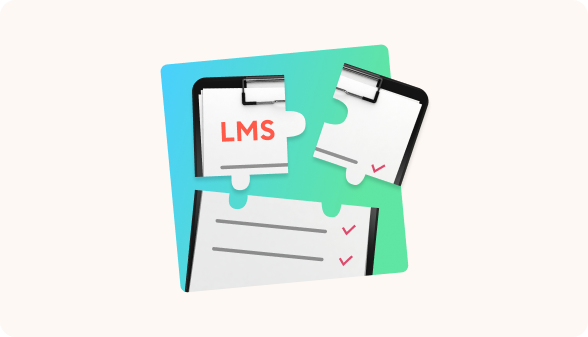LMS Requirements: An Ultimate Checklist

There are over 700 learning management systems (LMS) on the market today. It would take years to check out each one. But what if you need one right now? We prepared a list of key LMS requirements that will save you time and make the LMS selection process much easier.
Also read → How to choose the right LMS
LMS Requirements Checklist
We also put together a checklist for documenting LMS requirements. Use it to assess LMS options and identify the one that best suits your needs.
Just make a copy of the LMS requirements checklist, mark the features your company needs, like mobile learning support, learner engagement tools, and social learning features, compare these with what different LMSs offer, and select the vendor that meets all your standards.
See the LMS requirements checklist
Now let’s look at LMS requirements in detail.
Functional LMS Requirements
Functional requirements for LMS platforms include essential LMS features that learners and administrators use on a regular basis.
User and course management
These features encompass the ability to create, organize, enroll, and track users and training programs within the learning platform. LMSs approach these processes differently, but they all aim to offer administrators comprehensive control over learning content and user access.
When selecting an LMS, you need to decide how to work with users and groups in the LMS. To do this, answer these questions:
- How will you register employees? — will users register themselves, or will an administrator register them?
- Who will manage the LMS? Do you need a system that allows you to assign different user roles, such as administrators, publishers, SMEs (subject matter experts), and users?
- Do you plan to create individual training programs for different employees or organizations?
- How will you add new users — by email, by importing them from an Excel file, or both?
Opt for LMS solutions that automate administrative tasks, such as notifying learners of deadlines and new assignments. They will make training management a lot easier.
Learning models
Learning models represent the way eLearning content is structured and delivered to learners. Here are the main learning models:
- Pure eLearning. Employees are trained only online. They take courses and tests, and read recommended articles and books.
- Blended learning. Only part of the training is transferred to online learning. For example, you can ask employees to complete all the prerequisite courses through online learning and then undergo hands-on training in person. Blended learning is ideal for organizations that want flexibility while retaining face-to-face interaction.
- Instructor-led training. This type of employee training allows learners and instructors to interact and discuss the training material, either individually or in a group setting. Instructors might deliver training in a lecture or classroom format, or even virtually, using video conferencing tools. But transporting participants can be expensive!
To select the right LMS solution for your business goals, answer the following questions:
- Do you intend to host webinars? If yes, the LMS requirements checklist should include webinar software or integration with video conferencing services.
- Will you implement instructor-led training? If yes, then you need an LMS that allows you to manage classroom schedules and locations, monitor performance and attendance, and assign learners and instructors to offline sessions.
Support and creation of learning content
This is a major point on the LMS functionality checklist. To deliver quality training programs, it’s important to decide what kind of training materials you’ll offer to employees and if you’ll create courses in-house. Answer the following questions:
- What learning content formats do you plan to use — PDFs, Word documents, audio files, and/or video files? Which learning standard will you be working with: SCORM, AICC, or Tin Can? Make sure the LMS of your choice supports all the file and eLearning formats and data collection capabilities you need.
- Do you need a course editor or authoring tools to produce online learning content? Do you have a professional learning and development team, or will you create learning content on your own?
Some LMS platforms have a built-in editor that allows you to create simple tests and courses. That’s a good option if you already have a multimedia content library and need to deploy basic training programs or extra assessments quickly without extensive customization.
Other LMSs integrate with authoring tools. For example, iSpring Learn comes with iSpring Suite, an advanced, yet user-friendly tool for creating full-fledged interactive courses, assessments, training videos, and role-play simulations. Having an authoring tool enables you not only to create new training content, but also keep existing courses up to date with regular updates. The best thing is that you don’t need a professional learning and development team to craft professional-looking learning content with iSpring Suite.
Here’s an example of a course created with iSpring Suite.
To streamline the development of training programs, ensure that your LMS integrates seamlessly with authoring tools. These tools will empower your team to create interactive learning content tailored to your target audience, whether they’re internal employees or external learners.
Analytics and reports
This is one of the principal LMS requirements. Employee training is about results. That’s why you need to decide how you’re going to measure them, and an LMS frees you from having to work with Excel spreadsheets and process performance data manually.
Answer two questions to see which LMSs can meet your reporting needs:
- Do you need detailed LMS reports on materials, groups, and users, or is it sufficient for you to have a general notion of learners’ progress? Keep in mind that these analytics can also be used to drive improvement in both your training content and the learning system itself.
- Do you want to customize reports? Some LMSs allow you to create your own templates, i.e., automatically display the metrics you need in the form of charts, graphs, dashboards, etc.
Business Requirements for Learning Management Systems
Let’s move on to learning management system business requirements. These are tailored to meet specific business needs that organizations might have to propel their training programs and meet strategic goals effectively.
White-labeling and customization
This is one of the most widespread requirements for learning management system software. Consider whether you want to design the learning portal in a way that represents your corporate style. In some LMSs, you can only change color schemes and upload the company logo. Others let you completely redesign the interface so it blends seamlessly with the company’s brand standards and corporate websites. Some systems even allow you to move the learning platform to your own domain and change the interface of the mobile app. However, most LMS vendors charge an additional fee for that option.
You can also modify the interface of some LMSs with the help of widgets and page templates. For example, trainees will see only training programs that have been assigned to them and a calendar with upcoming events; trainers will see a list of users and their academic performance; and administrators will see additional configuration and tracking tools.
So, to figure out which LMS meets your business requirements, answer these questions:
- Do you want to have the interface in the style of your corporate website?
- Do you need to customize the interface for different roles?
eCommerce integration
If you want to monetize your training programs, look for an LMS with eCommerce integrations. These will enable you to sell courses and eLearning content seamlessly through your learning management system.
Integrations with SaaS platforms like Shopify allow you to set prices for course materials, promote them to your target audience, track sales, and manage income without having to integrate an eCommerce back-end.
Trainee certification
Do you want to provide employees with professional certifications or use official certificates as a corporate training incentive? Then look for an LMS that has the feature of issuing certificates upon completion of training modules or courses.
This feature is also a significant requirement for businesses that deliver certification training programs as a service. Automated certificate generation streamlines the process, ensuring accuracy and efficiency.
Customer success support
Customer tech support is a must-have for all learning management software users, but it’s especially important for enterprises that implement an LMS at scale. In such cases, prompt and efficient customer success support guarantees successful implementation, troubleshooting, and ongoing assistance to maximize the benefits of the LMS across the organization.
A customer success manager also helps businesses adapt the LMS to their unique training goals, develop effective training strategies, and optimize the use of the platform.
Compliance with eLearning standards
Most organizations require content standardization to ensure that courses are delivered in a consistent manner across systems and devices. SCORM, for example, has long been a major standard in the industry. The most prevalent versions include SCORM 1.2 and SCORM 2004 3rd Edition. However, APIs have recently become a powerful alternative for creating content standards and connections across all deployment options.
Choose an LMS that supports the online learning standards you’re comfortable with to ensure seamless integration and content delivery.
Deployment
An LMS can be deployed as a cloud-based or hosted solution. A hosted LMS is installed on a company’s server on premises, which means that all data is stored physically in-house. This is a great solution for those organizations that deal with sensitive data or follow strict compliance protocols.
However, deploying a hosted LMS is a complex, time-consuming process. It requires extensive technical expertise and resources to set up and maintain the infrastructure securely. Additionally, organizations must ensure continuous monitoring and updates to meet changing security and compliance standards. Systems often have to be integrated too. As a result, the setup phase can take 3–6 months or more.
A cloud-based platform is hosted on the web. It doesn’t require deployment, so you can start working with it immediately. Most LMS vendors offer cloud solutions, prioritizing scalability and accessibility for remote teams. With a cloud-based LMS, users can access the system from anywhere with internet access, which makes it ideal for remote teams and distributed workforce models.
Integration with other systems
Consider whether you need integration with third-party tools and systems to optimize your workflows. LMS integrations can include HR software, BI systems, CRMs, authoring tools, or numerous other services. For example, an integration with an HR system enables data migration which is beneficial for all companies — you don’t need to add employee info manually. And for instance, many healthcare organizations that train medical professionals will benefit from a learning platform that integrates with ACCME web services.
Also read: The 11 Best HR Tools for Streamlining Your Workflow
LMS Security Requirements
73% of executives believe remote workers pose a greater security risk than those that work from the office. An LMS contains a lot of confidential information. That’s why it’s crucial to ensure it has all the necessary data security requirements to prevent any data leakage issues.
Sensitive data protection
On the LMS features list, this element entails safeguarding confidential information, such as employee records, customer data, and proprietary content from unauthorized access or misuse.
When choosing an LMS, inquire about the software’s encryption protocols and make sure they align with industry standards for data security and encryption. For example, compliance with GDPR, HIPAA, or PCI DSS is key for organizations operating in regulated industries such as banking and finance, where they handle vast amounts of personal and financial data. That’s why their LMS of choice must provide tools for data anonymization, secure storage, and audit trails.
Authentication protocol
Consider the methods LMSs use to verify users and grant access to the platform. Many LMS vendors use the following authentication protocols:
- username/password
- single sign-on (SSO)
- multi-factor authentication (MFA).
To prevent unauthorized access, reduce the risk of data breaches, and maintain the integrity of the online learning environment, go for an LMS that meets your general user authentication standards.
Access control
This LMS qualification deals with the permissions and restrictions set for end users within the platform. Access control settings determine who can view or interact with specific learning content, features, and functionalities based on their roles and the overall organizational hierarchy.
With access control, administrators can manage user permissions quickly and easily to streamline user workflows and protect crucial data. It’s best to select LMS solutions with varied role-based access control parameters that are suitable for your organization’s structure.
Other Important LMS Standards and Requirements
Learning platforms have many extra features. Some of them may be helpful to you, while others can be unnecessary or even a distraction. It all depends on your business needs. Here are some of the most popular non-essential functionalities you can find (and put to good use) in learning platforms.
Social learning
Of course, it’s almost impossible to make people take courses daily, but you can motivate them to share and discuss interesting educational content with each other online.
If you want to leverage social collaboration, consider an LMS with social learning features. These systems are similar to social media in a way, where employees can publish articles, interact with colleagues on discussion forums, and like and share content. Instructors and experts can also add training content for employees and answer questions, if necessary.
Talent management
If you want to develop certain skills in employees, search for an LMS with a skills management feature. It allows you to choose necessary competencies and create training programs that close skill gaps and track individual users’ success.
Mobile learning
If you’re going to train sales representatives or other employees who are always on the move, your learning content should look great on all mobile devices. At the very least, you need an LMS that supports fully responsive courses that adapt to the screen size of mobile devices.
The ideal solution is a platform with a mobile app that allows learners to take courses offline. The latter will be especially helpful to those who travel a great deal and need access to courses on mobile devices while on airplanes or in other places with little or no internet connection.
Gamification
By receiving points and rewards for completed tasks, learners become even more deeply involved in corporate training programs and are encouraged to succeed. Most LMS vendors have taken this trend seriously and have added gamification elements to their LMSs: points, awards, ratings, badges, and more.
If you want to motivate your employees and increase learner engagement with the help of game mechanics, choose an LMS with gamification.
“When choosing an LMS, consider which options are especially important for you and which ones are not a big deal. For example, if you are an academy or a university that depends on grades and regular assessments, you will need a comprehensive LMS with a robust grading system and maximum security. On the other hand, if you are a company that just needs skill-based training or information delivery, you may not need a comprehensive grading system. You might also be interested in an LMS that’s mobile friendly and easy to use to facilitate corporate training for your employees.”

LMS Requirements by Organization Type
Choosing the right LMS depends heavily on your organization’s specific needs and goals. Different sectors, such as small and medium-sized businesses, educational institutions, extended enterprises, and regulated industries, have unique LMS requirements that must be addressed to ensure effective learning and compliance. Below is a breakdown of the main types of LMS requirements tailored to various types of organizations.
| LMS requirement types | Small and medium-sized businesses | Extended enterprises | Educational institutions | Regulated sectors |
| User and course management | – SSO Integration – Role-based access – Self-registration | – Multi-tenancy – Partner portals – Customer segmentation | – Batch enrollment – Parent access – Academic hierarchy | – Detailed audit trails – Mandatory enrollment – Auto-reassignment |
| Learning models and content creation | – Microlearning – Mobile access – Video capabilities | – Branded learning – Multiple languages – eCommerce integration | – Blended learning – Discussion forums – Assignment submissions | – Version control – Content expiration – Read receipts |
| Analytics and reports | – Skills gap analysis – Department benchmarking – Training ROI metrics | – Revenue tracking – Partner engagement – Customer satisfaction | – Grade book – Learning outcomes – Attendance tracking | – Completion documentation – Risk assessments – Regulatory reporting |
| LMS security requirements | – Data encryption – Password policies – IP restrictions | – Data segregation – Cross-domain security – Granular permissions | – Plagiarism detection – Exam proctoring – FERPA compliance | – Digital signatures – 21 CFR Part 11 compliance – Immutable records |
| Integration with other systems | – HRIS integration – Performance management – Talent systems | – CRM integration – Payment processors – Marketing automation | – SIS integration – Library systems – ePortfolio tools | – Document management – Identity verification – Digital certificate systems |
Note: “Regulated sectors” refers to organizations working under strict regulatory frameworks, such as healthcare, manufacturing, financial services, pharmaceuticals, and government contractors.
Things to Do Before Choosing an LMS
Before finalizing your LMS requirements checklist and starting to evaluate the LMS vendor market for your online learning projects, consider the following things:
Define your training goals and strategies
The best way to approach this step is to ask yourself:
- Why do you want to implement an LMS in your organization?
- What challenges will it solve?
- What business results do you expect to see?
For instance, if your business aims to improve the employee onboarding processes, your training goals might include reducing the time required for new hires to become productive and improving retention rates.
Now that you’ve pinpointed these objectives, you can identify the key LMS specifications and features, such as providing convenient onboarding modules and robust employee progress tracking features. In other words, having clear-cut training goals helps you see which aspects of the LMS are essential to achieve your desired outcomes.
Consider pricing plans
Another thing that will help you narrow down the choice is, of course, budget considerations. After all, when searching for a learning platform, there’s no avoiding the financial aspect.
To find the perfect system for your budget, compare pricing models across LMS vendors and pick one that’s most suitable for your company. There are several primary pricing models:
- Pay per active user. You pay only for those who use the system during each billing cycle.
- Pay per learner. Here, you’ll pay a fixed price for a fixed number of users, regardless of whether they are active or not.
- Pay as you go. You pay only for what you use — for example, users and the courses they take.
- License fee or subscription. You’ll pay a fixed price for a fixed period, like 1 year or 6 months, and add as many users and training materials as you need.
For more on which method of payment suits you best, read the full LMS pricing guide.
Other considerations
Other factors that have an impact on the process of choosing the best LMS for your business needs may include:
- User-friendly interface and overall intuitive user experience
- The vendor’s reputation
- Your organization’s learning culture
Check out our comprehensive guide on how to choose an LMS to learn more about LMS requirements, as well as other things to keep in mind.
Conclusion
Choosing the right LMS is a critical decision that directly impacts the success of your training initiatives, employee development, and organizational growth. By prioritizing key LMS requirements, you can ensure the platform aligns with your unique goals and workflows.
Don’t forget to make a copy of the LMS requirements checklist to simplify your evaluation process. This resource will help you compare vendors, prioritize features, and ensure that the LMS you choose meets all your organizational needs.









